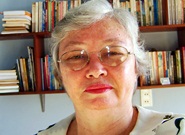|
Najda
Maria de Oliveira
Santos:
“It is a huge challenge
to reach out fellow
Spiritists in Brazil’s
second largest state”
The
president of the
Spiritist Union of Para
talks about the
Spiritist Movement in
the region and the
challenges that stem
from the huge size of
the state, in Brazil’s
Amazon region
 |
Najda Maria de Oliveira
Santos (photo),
born and bred in Pará
state, has been a
Spiritist since 1975.
She became president of
the state’s Spiritist
Union in 2006. She has
degrees in Education and
Business Administration
and has now retired from
the local state bank,
Banco da Amazonia. She
helped found three
Spiritist Centres along
the years in Pará. In
|
|
this interview,
she talks about
her experience
ahead of the Spiritist Movement in
such a unique region. |
Begin by telling a bit
more about Pará.
It is Brazil’s second
largest state. It
borders Suriname in the
north and the Atlantic
Ocean on the east. It
continues to be a major
producer of nuts –Para
nuts, as Brazil nuts are
known in the country –
but the main economic
activities are logging,
cattle ranching and
mining. It has huge
reserves of iron ore,
bauxite and copper.
There are 144
municipalities in the
state. The capital,
Belem, is known as “The
Metropolis of the
Amazon,” with a
population in its
metropolitan area of
some 2 million people.
When was the Spiritist
Union of Pará founded?
How did Spiritism begin
in the state?
In December 1905, a Navy
officer called Francisco
de Paula Menezes arrived
in Belém from Rio de
Janeiro. He made contact
with local Spiritists
and became a developed a
close friendship with an
Army officer, Francisco
Solerno Moreira. Paula
Menezes had taken part
in the Spiritist
Congress of October 3rd
1904, which marked the
100th
anniversary of Allan
Kardec’s birth.
Influenced by the
recommendations of the
congress, he set out to
create an organisation
that encompassed all the
existing Spiritist
Groups in the capital.
Solerno embraced the
idea and they began an
intensive programme,
visiting all Groups and
trying to get their
support. They obtained
the necessary support in
a very short time. On
May 20th
1906, the Spiritist
Union of Para was
founded. There are now
210 Groups in the state,
but not all are members
of the Union.
What are the main
challenges of looking
after the Spiritist
Movement in a state with
so unique conditions?
The challenge is to
reach out the Spiritist
Centres outside the
capital. The access is
very restricted in many
cases. Some areas can
only be reached by
plane. Others by river,
with different types of
boats – bigger, smaller,
faster, slower. The
journey can take from 5
hours to 4 days. To
carry out training
programmes and bring
volunteer workers to the
capital is a huge
challenge. And that
challenge gives everyone
the extra motivation we
need. We also have
Regional Spiritist
Councils, who gather
many municipalities and
do a great work in
trying to disseminate
the Teachings. They need
to be very creative
under the circumstances.
The headquarters of some
of the Councils are up
to 12 hours away other
municipalities, by boat
or bus. In some cases,
you need to travel
1,000km in bad roads to
reach the next Spiritist
Centre.
The capital, with a
privileged geographical
position and airport,
has good access to other
parts of the country.
How is the integration
between workers in Belem
and the interior?
The volunteers who make
the link with the
interior need plenty of
time in their hands.
Many are retired. We
gather all the
presidents of Regional
Councils in Belem once a
year to prepare our
annual strategy. Fellow
Spiritists from
neighbouring states help
us. And we often invite
Spiritists from other
parts of Brazil to come
to Para to take part in
conferences, talks and
lectures. They come to
the capital and often
travel to other areas in
the state.
What particular event or
experience would like to
highlight from all your
experience in the
Spiritist Movement?
The EIMEP – Portuguese
acronym for Intensive
Meeting of the Spiritist
Movement of Para. It is
in its 35th
edition and is
considered a congress,
as it gathers up to
1,000 people who come
for four days during the
carnival holidays and go
to a retreat. We have
children, young people,
adults, the elderly, all
gathered in a big school
taking part in a number
of activities.
Is there any particular
aspect of the Spiritist
Movement in Para that
you would like to
mention here?
I would like to mention
an event we had in
Redencao, in the south
of the state, in
December 2012. A group
of volunteers travelled
to the town where,
during two days, they
took part in a gathering
of Spiritist from seven
local municipalities.
The journey south from
Belem was fine: 20 hours
on a bus in a very bad
road, full of potholes;
a 1h30 plane journey to
follow; and finally 10
hours on a minibus until
arriving in Redencao.
They worked in different
groups according to
their age group. But the
return journey was a
drag. They needed to
reach the nearest
airport in Maraba by
2100 to catch a plane to
Belem. That journey
should take 8 hours in a
hired minibus. Well,
that minibus broke down.
Another one was sent to
take them and broke down
further down. The road
was awful. They could
only get to the airport
on a third minibus. They
got there exhausted, but
in high spirits, finding
the whole experience
very entertaining.
|